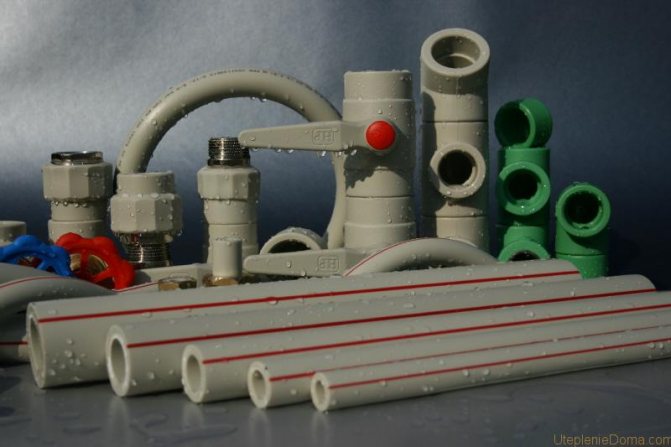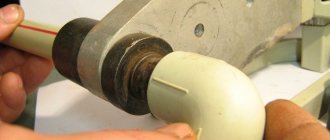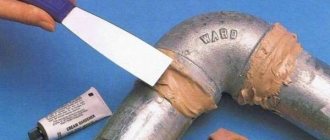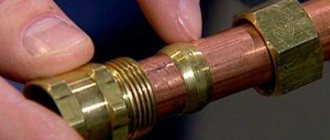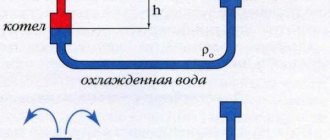When designing and installing a heating system, the question always arises - what diameter of the pipeline to choose.
The choice of the diameter, and hence the throughput of the pipes, is important, because it is necessary to ensure the speed of the coolant in the range of 0.4 - 0.6 meters per second, which is recommended by specialists. In this case, the required amount of energy (the amount of coolant) must be supplied to the radiators.
It is known that if the speed is less than 0.2 m / s, then air congestion will stagnate. A speed of more than 0.7 m / s should not be done for reasons of energy saving, since the resistance to fluid movement becomes significant (it is directly proportional to the square of the speed), moreover, this is the lower limit for the occurrence of noise in pipelines of small diameters.
What pipes should be used for the heating system?
Polypropylene pipes are divided into several types, which have their own technical characteristics, and they are designed for different conditions. Suitable for heating grades PN25 (PN30), which withstand an operating pressure of 2.5 atm at a liquid temperature of up to 120 degrees. WITH.
Wall thicknesses are given in the tables.
For heating, pipes made of polypropylene are now used, which are reinforced with aluminum foil or fiberglass. The reinforcement prevents significant expansion of the material when heated.
Many experts prefer pipes with internal fiberglass reinforcement. Such a pipeline has recently become the most widely used in private heating systems.
Features of pipes for heating
They are completely different when choosing the diameter of polypropylene pipes for heating. There are a lot of things that are important:
- Media temperature;
- Current speed;
- How long the pipeline will be;
- Pipe section and pressure generated by hot water.
The hydrodynamics of the entire heating system will depend on the diameter of the pipe. It is believed that the selection of pipes of the correct diameter in this case will help make the entire heating system correct and efficient.
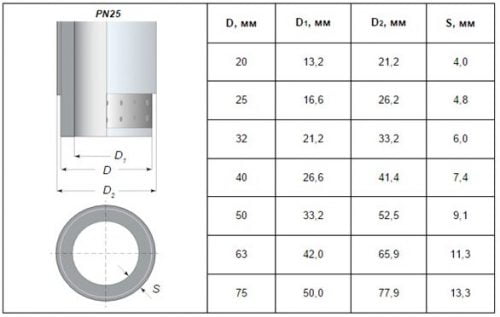
For private houses, communications from 16-40 mm pipes that will withstand the prescribed pressure remain in demand.
The color of a polypropylene pipe, and it can be white, gray or green, does not affect its quality. But this does not concern their black brothers at all. Pipes of this color have the highest degree of protection against ultraviolet rays.
If the question is what diameter of polypropylene pipes to choose, there are no particular difficulties. The private sector and apartment owners will take advantage of the recommendations, and there are special tables for other purposes.
But knowing the diameter isn't everything. The store always has a large selection of pipes from a variety of materials. For example, such pipes for heating are given from three types of plastic, only two of which can be used for hot water supply and heating.
The main advantage of polypropylene products, as already noted, is their durability. Subject to the recommendations for operation, such communications can last about 50 years, and as for cold water supply equipment, almost a century.
[art_yt id = ”VUzGe2sL1Xg” wvideo = ”640" hvideo = ”360" position = ”center” urlvideo = ”https://www.youtube.com/watch?v=VUzGe2sL1Xg” namevideo = ”Dimensions of polypropylene pipes” desc = ”The dimensions of polyethylene pipes and wall thicknesses range from: - average outer diameter of polyethylene pipes: from 10.0 (mm) to 1200.0 (mm): - tolerances for outer diameter in mm: from 0.3 (mm) to 6.0 (mm) . " durationmin = ”1” durationsec = ”00” upld = ”2015-06-15” tmburl = ”https://i.ytimg.com/vi/VUzGe2sL1Xg/maxresdefault.jpg” thumbnailwidth = ”1280" thumbnailheight = ”720" ]
Reading now
- Overview of the action of facers for all types of pipes
- Three ways to route pipes in the toilet and bathroom
- Overview of press fittings for pipes in the bathroom
- Choosing a small bathroom sink
Selection of the diameter of the heating pipeline
Pipes are available in standard diameters, from which you need to make a choice. Typical solutions have been developed for the selection of pipe diameters for heating a house, guided by which, in 99% of cases, you can make the optimal correct choice of diameter without performing a hydraulic calculation.
Standard outer diameters of polypropylene pipes are 16, 20, 25, 32, 40 mm. The inner diameter of pipes of grade РN25 corresponding to these values is 10.6, 13.2, 16.6, 21.2, 26.6 mm, respectively.
More detailed information on the outer diameters, inner diameters and wall thickness of polypropylene pipes is given in the table.
Home piping
In the case of a home pipeline, all the necessary calculations can be made using a simple formula, which initially requires only the exact value of the water flow rate and the total internal flow rate.
Technical characteristics of polypropylene pipes for heating
D = square root of (4-Q-1000 / n * v), where n = 3.14, v = 0.7-1.2 m / s (up to 32 mm) or 1.5-2 m / s (32 mm or more).
according to this formula, the value of the water flow rate is taken as Q. When using pipes in apartment buildings, the calculation must be performed with caution and observation. For each riser, the diameter of the polypropylene pipes is 32 mm.
What diameters what to connect
We need to ensure the supply of the required thermal power, which will directly depend on the amount of heat carrier supplied, but the speed of fluid movement should remain within the specified limits of 0.3 - 0.7 m / s
Then there is such a correspondence of the connections (for polypropylene pipes, the outer diameter is indicated):
- 16 mm - for connecting one or two radiators;
- 20 mm - for connecting one radiator or a small group of radiators (radiators of "normal" power within 1 - 2 kW, maximum connected power - up to 7 kW, the number of radiators up to 5 pcs.);
- 25 mm - for connecting a group of radiators (usually up to 8 pcs., Power up to 11 kW) of one wing (arm of a dead-end wiring diagram);
- 32 mm - for connecting one floor or a whole house, depending on the thermal power (usually up to 12 radiators, respectively, the thermal power up to 19 kW);
- 40 mm - for the main line of one house, if there is one (20 radiators - up to 30 kW).
Let us consider the choice of the pipe diameter in more detail, based on the previously calculated tabular correspondences of energy, speed and diameter.
Classification of PPR pipes
The production of polypropylene pipes is carried out in accordance with GOSTs, which strictly regulate the parameters of the products. The outer diameter can vary from 1 to 120 mm, and the wall thickness also varies.
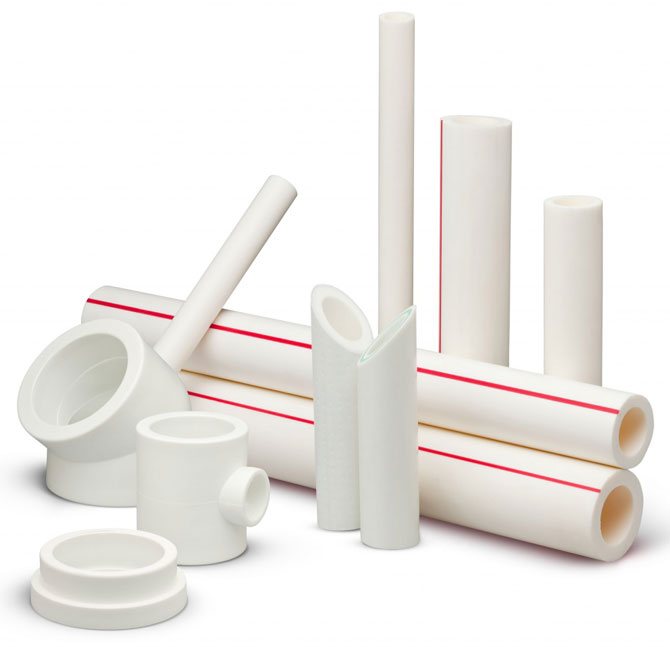

For the device of household communications, pipes of no more than 50 mm are usually used, but it's not just size that's important to consider. Working pressure and material composition are also important. The combination of these characteristics allows you to choose the best option for heating and sewerage systems.
By composition
Polypropylene used in the production of pipes, depending on the chemical composition, gives the finished product certain properties. According to the manufacturer's marking, you can determine the purpose of the pipe:
- PPH is a homopolymer with fillers that increase impact resistance. Pipes from it are used for drainage and cold water supply, as well as ventilation. PPH pipes are incompatible with coolants, since an increase in temperature causes significant deformation;
- PPR (same as PPRC) is a random copolymer, the most popular variety. Due to the crystalline structure at the molecular level, the material is highly durable, resistant to temperature extremes and aggressive substances. PPR pipes have a size range from 16 to 110 mm, are used for laying hot and cold water supply systems, heating pipelines;
- PPB is a block copolymer with a special molecular structure.Pipes from it are used mainly for underfloor heating and cold water supply communications;
- PPs - polyvinyl sulfate resistant to high temperature values, from which heat-resistant pipes withstand heating up to 95⁰С are made. Designed for heating systems and installation of hot water pipelines.
We recommend that you familiarize yourself with: PP pipes for cold and hot water supply
Note! For household communications, products with PPR marking are usually used, which, due to their technical characteristics, are suitable for a variety of purposes.
Working pressure
Another important parameter that determines the purpose of polypropylene pipes is the ability to withstand pressure. It is designated on products with Latin letters PN and numbers, has several varieties:
- PN10 - a pipe with this marking is designed for a nominal pressure of about 10 atmospheres (or 1 MPa). It is used only at temperatures of the carrier not higher than 20С, that is, for the device of cold water supply systems;
- PN16 - the working pressure should not exceed 16 atmospheres, and the temperature of the supplied water should not exceed 60⁰С. Such characteristics are optimal for communications supplying both cold and hot water;
- PN20 - this is the designation for a nominal pressure of 2 MPa (or 20 atmospheres) on a pipe wall with a thickness of 16 mm. Products with such markings are most often used in the construction of water supply communications. The maximum media temperature should not exceed 80 превышатьC;
- PN25 - pipes marked in this way are designed for a nominal pressure of about 25 atmospheres and withstand temperatures up to 95⁰С. The product is reinforced with an aluminum layer that increases its strength. It is used in heating systems, as well as hot water supply.
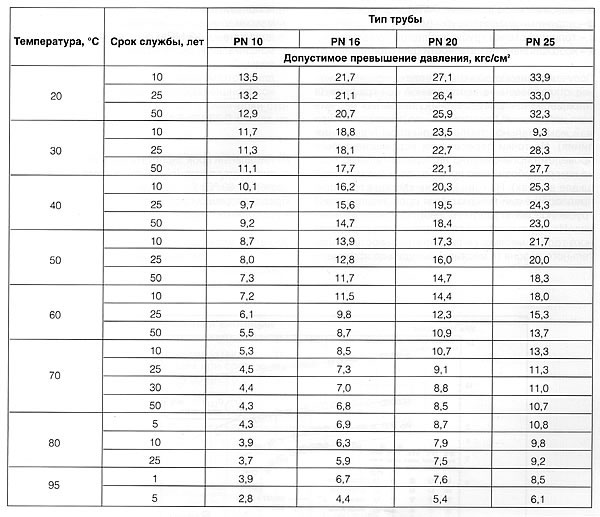

Note! If the permissible values of pressure on the wall are periodically exceeded, the pipeline will not depressurize, but its service life will be significantly reduced. Therefore, the specifications must strictly comply with the conditions of use.
Selection of pipes by capacity
It can be seen from the table that at a speed of 0.4 m / s, approximately the following amount of heat will be supplied through polypropylene pipes of the following outer diameter:
- 4.1 kW - inner diameter about 13.2 mm (outer diameter 20 mm);
- 6.3 kW - 16.6 mm (25mm);
- 11.5 kW - 21.2 mm (32 mm);
- 17 kW - 26.6 mm (40 mm);
And at a speed of 0.7 m / s, the values of the supplied power will already be about 70% higher, which is not difficult to find out from the table.
How much heat do we need?
Where are polypropylene pipes used?
Polypropylene pipes appeared on sale not so long ago, nevertheless, they are already very popular.
There are a number of advantages that distinguish them from their counterparts:
- the material is not subject to oxidation;
- can be used in environments with aggressive conditions;
- low cost;
- do not conduct electric current;
- pipes are easy to lay;
- look great.
It should be noted that PP pipes can be used not only as an internal water supply.
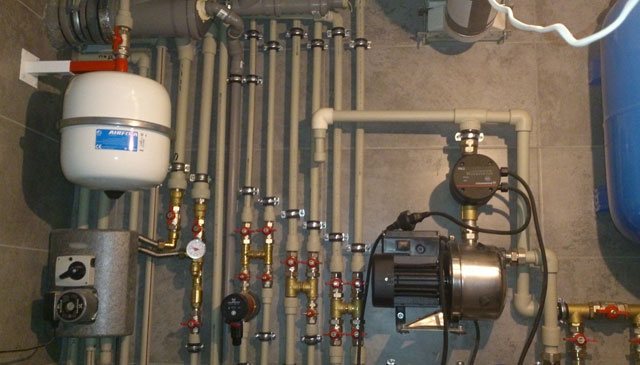

Additionally, they can be used to equip:
- Ventilation systems. Even the large outer diameter of polypropylene pipes leaves them lightweight, without creating large loads on partitions made of wood framing and plasterboard sheathing, for example.
- Sewers. The material is not afraid of aggressive substances.
- External plumbing with cold water supply.
Since polypropylene is not as strong as cast iron, it needs protection in some places. If pipes are laid under roads, it is better to build a reinforced concrete box.
The advantages include the fact that deposits do not accumulate on the inner walls of polypropylene pipes. Due to their elasticity, such pipes will not be damaged by frost.
How much heat should the pipeline supply
Let us consider in more detail, using an example, how much heat is usually supplied through the pipes, and select the optimal diameters of the pipelines.
There is a house with an area of 250 square meters, which is well insulated (as required by the SNiP standard), so it loses heat in the winter by 1 kW from 10 square meters. To heat the whole house, an energy supply of 25 kW (maximum power) is required. For the first floor - 15 kW. For the second floor - 10 kW.
Our heating scheme is two-pipe. A hot coolant is supplied through one pipe, and the cooled one is discharged through the other to the boiler. Radiators are connected in parallel between the pipes.
On each floor, the pipes branch out into two wings with the same heat output, for the first floor - 7.5 kW each, for the second floor - 5 kW each.
So, from the boiler to the interfloor branching, 25 kW comes in. Therefore, we need main pipes with an internal diameter of at least 26.6 mm so that the speed does not exceed 0.6 m / s. Suitable for 40mm PP pipe.
From the interfloor branching - along the first floor to the branching on the wings - 15 kW is supplied. Here, according to the table, for a speed of less than 0.6 m / s, a diameter of 21.2 mm is suitable, therefore, we use a pipe with an outer diameter of 32 mm.
7.5 kW goes to the wing of the 1st floor - an inner diameter of 16.6 mm is suitable, - polypropylene with an outer diameter of 25 mm.
For each radiator, the power of which does not exceed 2 kW, you can make a branch with a pipe with an outer diameter of 16 mm, but since this installation is not technologically advanced, pipes are not popular, more often a 20-mm pipe with an inner diameter of 13.2 mm is installed.
Accordingly, we accept a 32mm pipe on the second floor before branching, a 25mm pipe on the wing, and we also connect radiators on the second floor with a 20mm pipe.
As you can see, it all comes down to a simple choice among the standard diameters of commercially available pipes. In small home systems, up to a dozen radiators, in dead-end distribution schemes, polypropylene pipes are mainly used 25 mm - "on the wing", 20 mm - "on the device". and 32 mm “to the boiler line”.
Compliance
- polypropylene pipes with an inner diameter of 10 mm have an outer diameter of 16 mm;
- polypropylene pipes with an inner diameter of 15 mm have an outer diameter of 20 mm;
- polypropylene pipes with an inner diameter of 50 mm have an outer diameter of 63 mm;
- polypropylene pipes with an inner diameter of 100 mm have an outer diameter of 125 mm.
The table above is intended to provide additional dimensions for PP tubing. In cold water supply systems and sewers, a pipe with a large diameter is used.
In heating and hot water systems, the use of such pipes is prohibited due to the nature of the material and its original purpose according to the specification.
If it is necessary to provide water supply for an entire neighborhood and more, polypropylene pipes with a minimum diameter of 500 mm will be needed. In the event that this diameter is not enough, larger dimensions are used.
Features of the choice of other equipment
The diameters of the pipes can also be selected according to the conditions of the hydraulic resistance for atypically long pipelines, at which it is possible to go beyond the technical characteristics of the pumps.
But this can be for production workshops, but in private construction it practically does not occur.
For a house up to 150 square meters, according to the conditions of the hydraulic resistance of the heating radiator system, a pump of type 25 - 40 (pressure 0.4 atm) is always suitable, it can also be suitable up to 250 square meters in some cases, and for houses up to 300 square meters ... - 25 - 60 (head up to 0.6 atm).
The pipeline is designed for maximum capacity. But the system, if ever, will work in this mode, it will not be for a long time.When designing a heating pipeline, it is possible to take such parameters that at the maximum load, the speed of the coolant is 0.7 m / s.
In practice, the speed of the water in the heating pipes is set by a pump that has 3 rotor speeds.
In addition, the supplied power is regulated by the temperature of the coolant and the duration of the system's operation, and in each room it can be regulated by disconnecting the radiator from the system using a thermal head with a pressure valve.
Thus, with the diameter of the pipeline, we ensure that the speed is within the range of up to 0.7 m at maximum power, but the system will generally work with a lower speed of fluid movement.
Source: teplodom1.ru/radiattopl/114-kakoy-diametr-trub-iz-polipropilena-dlya-otopleniya.html
Required data for calculation
The main task of heating pipes is to deliver heat to the heated elements (radiators) with minimal losses. From this we will build on when choosing the correct pipe diameter for heating a house. But in order to calculate everything correctly, you need to know:
- pipe length;
- heat loss in the building;
- power of elements;
- what kind of piping will be (natural, forced, one-pipe or two-pipe circulation).
The next point, after you have all the above data on hand, you will need to sketch a general diagram: how, what and where it will be located, what heat load each heating element will bear.
Then you can begin to calculate the required cross-section of the pipe diameter for heating the house. You should also be careful when buying:
- metal-plastic and steel pipes are marked according to the size of the inner diameter, there are no problems;
- but polypropylene and copper ones - in the outer diameter. Therefore, we need to either measure the inner diameter ourselves using a caliper, or subtract the wall thickness from the outer diameter of the pipe for heating the house.
Do not forget about this, because we need exactly the "inner diameter of the pipe for heating the house" in order to calculate everything correctly.


Choosing a diameter for your heating
Do not count on the fact that you will be able to choose the right pipe diameter for heating your house right away. The fact is that you can get the desired efficiency in different ways.
Now in more detail. What is most important in having the right heating system? The most important thing is uniform heating and delivery of liquid to all heating elements (radiators).
In our case, this process is constantly supported by a pump, thanks to which, for a specific time period, the liquid moves through the system. Therefore, we can choose from only two options:
- buy pipes of a large cross-section and, as a result, a low flow rate of the coolant;
- or a pipe of small cross-section, naturally, the pressure and the speed of fluid movement will increase.
Logically, of course, it is better to choose the second option for the diameter of pipes for heating a house, and for the following reasons:
- when laying pipes externally, they will be less noticeable;
- when laying inside (for example, in a wall or under the floor), the grooves in the concrete will be more accurate and easier to hammer;
- the smaller the diameter of the product, the cheaper it is, of course, which is also important;
- with a smaller pipe cross-section, the total volume of the coolant also decreases, thanks to which we save fuel (electricity) and reduce the inertia of the entire system.
And working with a thin pipe is much easier and easier than with a thick one.
To always be with water and warmth
It seems that it is quite understandable: the cross-section of polypropylene pipes depends on their intended use. Therefore, you must immediately choose what you specifically need. After all, the larger the diameter of the product, the more you will have to pay for it. But such an accurate calculation is usually necessary for large needs.
But if it is necessary to install household communications, diameters of 20-25 mm are usually suitable, and for cold water - often 16 mm.Polypropylene products of large cross-section (over 500 mm) are not used at all.
It will be interesting: How not to make mistakes when soldering plastic pipes
It is quite understandable that there is always a temptation to install a pipe of a much larger diameter beyond the calculated one. But here you shouldn't forget about the cost. After all, a pipe with a larger section will cost more. And if we also add here the cost of various devices for installing pipes, then as a result we will get very impressive costs, which can simply be avoided and be with water or heat.
For arranging a water supply riser in a five-story building, for example, a polypropylene pipe diameter of 25 mm is suitable, for 6-9-storey buildings it is better that they are 32 mm in cross section.
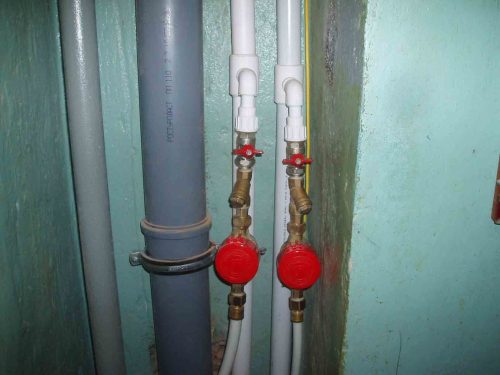

A complex calculation is not required to determine the diameter and number of pipes and when constructing communications in private buildings. In this case, there are not many water intake points, and the cost difference between the pipes, with an insignificant number of them, will not be negatively reflected even on a modest family budget. Based on this, the owners of private houses and apartments purchase polypropylene pipes of 20-32 mm diameter, which will suit them for arranging proper plumbing equipment.
The formula for calculating the diameter of a pipe for heating a house
For example, we will select a cross-section for a copper pipe in direct proportion to how powerful the radiators are.
All pipes are manufactured in accordance with GOST. Consequently, all diameters are known in advance, as well as the amount of useful heat that they can pass through themselves, depending on the section and pressure.
Therefore, it is not necessary to calculate every time that which has long been calculated and recorded in special tables. All that is required is simply to find a table with data that suits you and, using it, select the diameter of the pipe for heating the house.
How were these tables created? It's very simple. Take this formula for calculating the diameter of the pipe, count, and write down the result, and so on for all sections:
D = √ (354 * (0.86 * Q / ∆t) / V)
Wherein:
V is the velocity of the liquid in the pipe (m / s); Q is the required amount of heat for heating (kW); ∆t is the difference between reverse and direct feed (C); D - pipe diameter (mm).
You can try to calculate everything yourself.
It is known that in individual heating systems the coolant moves at a speed of 0.2-1.5 m / s. It is also known that the ideal speed should be in the range of 0.3-0.7 m / s.
If the speed is higher than the optimal values, then the noise increases, and if it is less, then air jams may appear. For this, there are already ready-made tables. In them, we choose the speed that suits us.
There are tables for copper, polypropylene, metal and metal-plastic pipes. They have ready-made solutions for working in medium and high temperatures. For clarity, let's look at specific examples.
How to choose PP pipes
In order to correctly choose a durable and ideally suited product in terms of technical parameters, you need to know a number of facts about polypropylene as a material.
There are several options and they are distinguished depending on the degree of modification of the main component, to which the stabilizing additives are mixed. In general, PPR pipes demonstrate high technical parameters:
- wide temperature range - -170ᵒС - + 1400ᵒС;
- resistance to temperature changes;
- mechanical strength;
- indifference to aggressive chemical environments.
There are PPH, PPs and PPB raw materials, which differ in molecular structure, and therefore have a difference in characteristics and scope.
- RRH. This type is more suitable for cold water supply and sewerage systems, but is not suitable as pipes for heat transfer fluids, since they have a low melting point.
- РРВ. The structure is characterized by the presence of blocks of micromolecules alternating with each other in a certain order.Hence, there is a high mechanical strength, resistance to high temperatures and the possibility of using products for heating systems.
- PPs, or polyphenyl sulphides, characterized by a special structure and high strength characteristics, which determine the possibility of using it in heating networks.
In addition, PP pipes are distinguished by pressure. This parameter is labeled as N10 (PN10), N25 (PN25) and so on. This characteristic is necessary for understanding, since it can be used to judge the acceptability of using a particular type of pipe to the pressure conditions in the system. The figure indicates the maximum allowable pressure in the system and corresponds to the data given in bar, that is, N10 pipes are designed for a pressure of 10 bar, or 1.0 MPa.
Calculation of the diameter for a two-pipe heating system
We will count on the example of a simple house with two floors. We have two wings on each floor. A two-pipe heating system with the following parameters will be installed in the house itself:
- total heat loss - 36 kW;
- loss on the 1st floor - 20 kW;
- loss on the 2nd - 16 kW;
- polypropylene pipes installed;
- system operation in 80/60 mode;
- temperature - 20 C.
Below is a table (a), based on the data of which, we will determine the desired pipe diameter. Cells with the best (optimal) fluid velocity are marked in green in the table.
We count. Through the section of the pipe that connects the first fork and the boiler, the entire volume of liquid passes, therefore, all the heat, and this is 38 kW. Let's determine which pipe to take here.
We take our table, look for the corresponding line in it, then go through the green cells and look up. What do we see? And we see that with such parameters, two options are suitable for us: 50 and 40 mm. Naturally (as described above), we choose a smaller pipe diameter for heating a house of 40 mm.


Then we look at the fork that divides the movement of the coolant into the second and first floors (16 and 20 kW). Again, we look at the values in the table and we find that a pipe diameter of 32 mm is needed in both directions.
We have two wings on each floor. The path is also split into two branches. We consider the first floor:
20 kW / 2 = 10 kW per wing
Second floor by analogy:
16 kW / 2 = 8 kW per wing
Again, we take our table and determine that in these areas we need a pipe with a cross section of 25 mm. It is also clearly seen from the table that we use such a diameter until the load drops to 5 kW, then we will use pipes of 20 mm.
Important! From personal experience, I can say that it is better to switch to a pipe diameter of 20 mm when the heat load is not 5 kW, but 3 kW.
In such a simple way, we calculated all the pipe diameters for heating the house of the polypropylene pipes we need for a two-pipe heating system.
For the return water supply, you do not need to calculate anything, everything is much simpler there: you do all the wiring with pipes of the same diameter as for the direct supply. As you can see, there is nothing complicated. All you need is a good, appropriate table.
Some nuances of calculating the diameter for metal pipes
If you decide that you will use metal pipes for the heating system, then you need to take into account that they lose heat. In small areas, this is almost invisible.
But on extended systems, it can happen that the very last heating elements in the chain are cold or slightly warm. This is also a consequence of the wrong choice of the pipe diameter. Fortunately, heat loss can be easily calculated:
q = k * 3.14 * (tv-tp) q - heat loss per meter (W / s); k is the heat transfer coefficient (W * m / s); tв - temperature of hot supplied water (С); tp - ambient temperature (C).
Let's take a pipe with a diameter of 40 mm. Let's say the wall is 1.4 mm thick. Material - steel. Let's calculate:
q = 0.272 * 3.15 * (80 - 22) = 49 W / s
Here is another proof of why you need to take the diameter of a pipe for heating a house with a smaller diameter. After all, it is clear that the thicker the pipe, the more heat we will lose.
And in this example, we got losses of almost 50 W per 1 meter of distance. And if the system is quite extended, then you can lose all the heat.
But don't be discouraged! Such accurate calculations are needed only for multi-storey residential buildings. For individual heating systems, everything is simpler: the calculations are rounded up and this gets a certain margin.
Where to get tables?


Everything is simple here. Usually, all detailed tables with all the necessary data can be viewed (or downloaded for yourself) on the websites of pipe manufacturers. But sometimes there are no tables.
You can get out of this situation as follows. If there are no tables for the outer diameter, then take it for the inner diameter, and calculate using it. Yes, there will be inaccuracies, but, as experience shows, for forced circulation they are absolutely insignificant and permissible.
Having analyzed a huge number of already installed and perfectly working systems, experts noticed a certain pattern in the choice of the pipe section. It is mainly suitable for small stand-alone systems.
In private houses, the pipes that come out of the boiler are most often one-half and three-quarters in size. Such a pipe diameter for heating a house is used before the first fork, and at each next one, the section is reduced by exactly one step.
But this method is applicable only for apartments and one-story houses, for high-rise buildings, alas, you have to calculate everything very carefully.
If we have a private house or apartment, autonomous heating for no more than 5-8 radiators and 2-3 forks, we can easily calculate everything ourselves. We need to know how powerful each heating point is, the heat loss in the room and a good table for selecting the pipe diameter.
However, as it has already become clear, trust experienced specialists to calculate a complex multi-level system with numerous joints and forks. Well, if you still decide to do everything yourself, then at least read articles such as ours and consult the experts.
Source: eurosantehnik.ru/kak-vybrat-diametr-truby-dlya-otopleniya-doma.html
How to choose the right pipes of the required diameter
In cases where heating is carried out in a private house or cottage, then the pipes must be selected taking into account the fact that the diameter will not change only when there is a direct connection to the central heating system. In the case of an autonomous pipe system, any size (different diameter and length) can be used, depending on the preferences of the owner of the house.
Related article: How to make a table from a stool?
When choosing the necessary blanks, you need to take into account all the features, especially when it comes to a natural heating system, where the ratio of the cross section to the pump power will not be a primary feature. This fact is attributed to the advantages of this heating system.
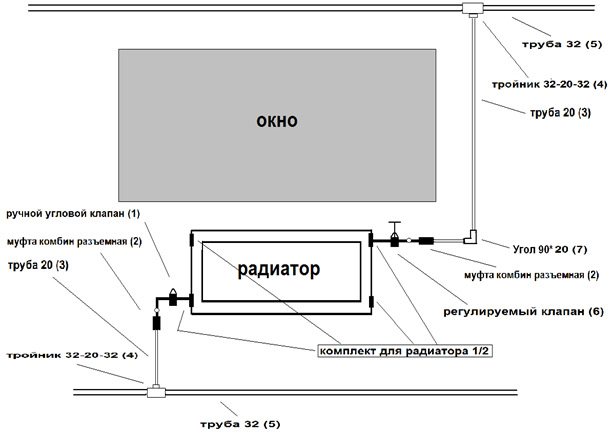

Pipe installation diagram.
The disadvantage of such a system is the small radius of action and the high cost of large elements used in this case.
To ensure the efficiency of the system, it is necessary to maintain a certain level of pressure in it, which allows the water moving inside to overcome all obstacles in its path. Resistances (obstacles) can be in the form of water friction against walls, a drain or a tap and a heating device. The most interesting thing is that the resistance and the speed with which water will flow depends on the length and diameter of the pipeline. With a high water velocity, a small cross-section and a long pipeline, the level of resistance on the path of the water increases.
How to choose the right pipe diameter for heating a house - table and calculations
It is not difficult for a professional to calculate the optimal cross-section of the pipeline.Practical experience + special tables - all this is enough to make the right decision. But what about an ordinary home owner?
Indeed, many people prefer to install the heating circuit on their own, but at the same time they do not have a specialized engineering education. This article will be a good tip for those who need to decide on the diameter of the pipe for heating a private house.
There are several nuances that you need to pay attention to:
- Firstly, all the data obtained on the basis of calculations using the formulas is approximate. Various rounding of values, averaged coefficients - all this makes a number of corrections to the final result.
- Secondly, the specifics of the operation of any heating circuit has its own characteristics, therefore, any calculations give only approximate data, "for all cases."
- Thirdly, pipe products are produced in a certain range. The same applies to diameters. The corresponding values are located in a certain row, with gradation according to values. Therefore, you will have to select the denomination that is closest to the calculated one.
Based on the foregoing, it is advisable to use the practical recommendations of professionals.
All Du - in "mm". In brackets - for systems with natural circulation of the heat carrier.
- The common pipe of the line is 20 (25).
- Taps to batteries - 15 (20).
- With a one-pipe heating system - diameter 25 (32).
But these are general parameters of the contour that do not take into account its specifics. More precise values are shown in the table.
What is taken into account when choosing a pipe diameter
Heat generator power. It is taken as a basis and is determined individually for each building. What does the owner focus on when purchasing a boiler?
The total area of all heated premises. This is what the manager at the point of sale will definitely clarify if the buyer has questions about this item.
On a note! It is generally accepted that in order to ensure high-quality heating of a house, it is necessary to adhere to the following ratio - 1 m2 / 0.1 kW. But if we take into account the peculiarities of the climate, the sparing mode of operation of the unit (so as not to "drive" it to the limit), then about 30% should be added. It turns out - 1 / 1.3.
Coolant speed. If it is less than 0.25 m / s, then there is a risk of airing the system, the formation of traffic jams on the highway. Exceeding the value of 1.5 is fraught with "noise" in the line.
This is especially noticeable when the pipes are metal, and even laid in an open way. But in any case, the movement of the coolant along the route will be well monitored.
Practice has proven that for a private building (with an autonomous heating circuit), one should focus on an indicator in the range from 0.3 to 0.7. This is the optimal value for any system.
Loop configuration. In private houses, during its installation, as a rule (regardless of the scheme), all "threads" are brought to the collector. Each of them is "loaded" on a certain number of radiators.
It makes no sense to purchase pipes of the same diameter for all lines, given that the larger the section of the workpiece, the higher the price of 1 running meter.
Pipe diameter. The outer one does not play a special role, since products from various materials have differences in wall thickness. This parameter only indicates the convenience of fastening the product. Inner diameter - about the throughput of the route. It is he who is decisive.
On a note! It is customary to operate with the averaged value of the section size (nominal diameter). It is this parameter that is used in the calculations.
It is customary to designate pipe diameters in inches. For us, this is an unusual (not metric) system, so you should know the rules for converting values. The ratio of inch to centimeter is ½.54 (or 25.4 mm). Pipe material - metal-plastic, steel, PP, PE.
The specifics of the structure. First of all, this relates to the effectiveness of its thermal insulation - from what materials it is mounted, by what method, and so on.
Classification and selection
Nowadays, the production provides a significant selection of plastic pipes. To understand all the abundance, you need to have an understanding of the rules for their application. The main thing in this is to be able to classify products by their application and section.
Polypropylene pipes are divided into:
- PN 20 (having high shockproof strength) - they are used for the equipment of ventilation systems, water pipes, floors with water heating. They are, as a rule, large in diameter and do not withstand cold well (become brittle);
- PN 10 (have normal strength) - suggest a wide range of applications, therefore they are in demand among buyers. They are resistant to sudden changes in temperature, which allows them to be equipped with a plumbing system, and used when arranging floors with warm water heating;
- PN 25 (reinforced, that is, provided with various inclusions of aluminum or fiberglass foil) - are distinguished by the greatest indestructibility and durability. They go well for laying outdoor systems and communications, with centralized heating, when supplying compressed air. These pipes, as a rule, are cost-effective, but also win-win in operation.
Numerical designations (10, 20, 25) indicate the limit of permissible pressure (in kg / cm2) in pipes.
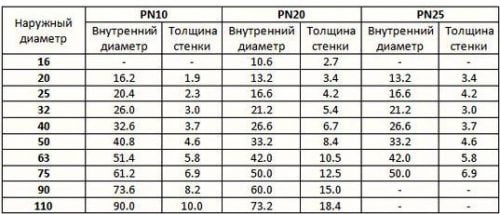

What do the diameters of polypropylene pipes say?
Judging by the application, the diameters of the pipes have different indicators, but in all pipes they are internal and external.
It will be interesting: How to eliminate noise and hum in a water supply pipe on your own
External ones indicate their ability to solve various construction problems:
- Pipes with a relatively small cross-section (5, 10, 15, 20, 25, 32, 40, 50, 63, 75 mm) are very convenient in the equipment of heating communications, when laying water pipes and drainage systems in private buildings, as well as apartments. At the same time, the supply of hot water will be provided by 20 mm products; pipes with a diameter of 25 mm will fit on the risers. Arrangement of a warm floor will turn out well from pipes of 16-18 mm cross-section. They bend easily, so they can be shaped to the desired shape;
- 80, 90, 100, 110, 125, 160, 200, 250, 315 - mm are also suitable for water supply and drainage systems, replacing cast iron pipes with a similar external section used for these purposes. 200 mm are used in the construction of large buildings where a significant number of people are expected to stay (shops, clinics, hotels, etc.);
- Products with a cross section of 400 mm and more are suitable for pumping water in large volumes, as well as for ventilation systems.
Which of them is better to use in one case or another is easiest to find out from special tables. However, for private construction, such complex and meticulous costs do not apply. In fact, for such buildings, polypropylene pipes with a 20-25 mm cross section are usually used.
Note that all of the above refers to the selection of this important part of communications, given their diameter. But when purchasing pipes for a particular purpose, it is important to study their operational boundaries, in particular to ask what temperature and pressure can withstand, installation features, type of connection, etc.
Throughput of various pipe diameters
In addition to all this, the pipes still differ in passability. Actually, the inner diameter of polypropylene pipes determines the amount of liquid that this or that product can pass through in a certain fraction of time. But the size of the external section does not play a role here. But it, and, consequently, the thickness of the walls of the pipe, indicates how strong it is and is able to cope with pressure.


The ratio of both cross-sections of plastic pipes is usually as follows:
- The outer 16 mm corresponds to the inner 10 mm section;
- 20mm - 15mm;
- 63mm - 50mm;
- 125mm - 100mm.
Calculation of the throughput capacity of the pipe section is very important when equipping water supply in high-rise buildings. After all, the slightest miscalculation, which will lead to the use of communications with a smaller cross-section of pipes, can lead to the fact that at the peak of the greatest water consumption (for example, in the evening), it simply will not reach the upper floors.


